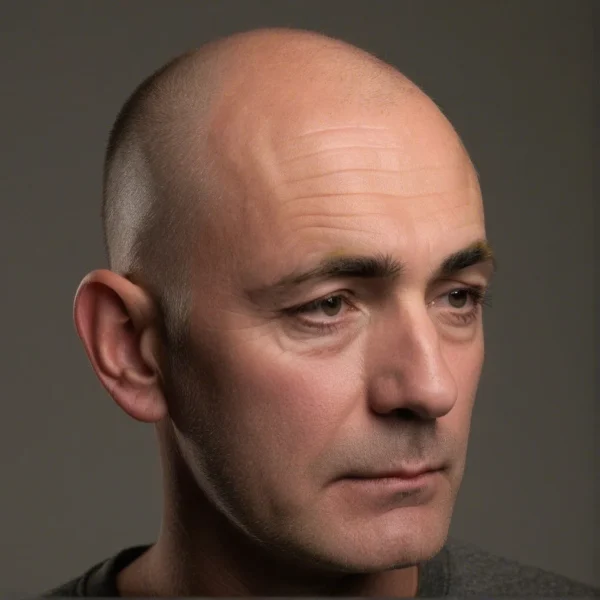Introduction: An uneven hairline refers to a condition where the hairline lacks symmetry across the forehead or scalp, giving a visually unbalanced appearance. Hairlines naturally vary in shape and thickness among individuals, but significant unevenness may cause cosmetic concerns. Uneven hairlines can develop due to genetic predisposition, environmental factors, or lifestyle habits. They may also be a result of underlying medical conditions that affect hair growth and scalp health.
In this article, we will explore the anatomy of hairlines, the causes behind an uneven hairline, and the treatment options available. This will include both medical interventions and lifestyle changes that can help manage the appearance of an uneven hairline. We will also delve into methods to prevent further asymmetry or hair loss.
Anatomy of a Hairline: The hairline is defined as the edge where the scalp transitions to the forehead, framing the face. It typically takes one of several standard shapes, such as straight, M-shaped, or widow’s peak. A perfectly symmetrical hairline is rare; most individuals have some degree of asymmetry. However, the asymmetry can become noticeable or progress over time, leading to concerns about appearance. Hair density, growth direction, and the presence of “baby hairs” also influence the appearance of the hairline. Any factor that disrupts normal hair growth—whether through hormonal changes, scalp conditions, or physical trauma—can contribute to unevenness.
Common Causes of an Uneven Hairline: Uneven hairlines can arise from several factors, ranging from natural aging to more complex medical conditions. Some of the most common causes include:
Genetic Factors: Genetic predisposition is a significant factor in determining hairline shape and symmetry. Some individuals naturally inherit uneven hairlines or patterns and these inherited patterns can shift over time and increasing age. For instance, some people can hae a strong family history of uneven hairlines. Other people with a family history of male or female pattern baldness (androgenetic alopecia) may notice gradual changes in their hairline, consistent with the experiences of other family members, including uneven receding.Androgenetic Alopecia: One of the most common causes of uneven hairlines is androgenetic alopecia (AGA), a form of hair loss driven by the hormone dihydrotestosterone (DHT). In men, the condition often begins with a receding hairline that creates an “M” shape, which may appear uneven as one side recedes more quickly than the other. Intriguingly, in one study, the majority of men with AGA exhibited significantly more extensive recessions on the right-side frontotemporal region. In women, androgenetic alopecia usually results in diffuse thinning, but it can also cause an uneven hairline in some cases.Traction Alopecia: Traction alopecia occurs when hair is repeatedly pulled or stressed by tight hairstyles, such as ponytails, braids, or extensions. This can lead to damage of the hair follicles and eventual hair loss along the hairline, creating unevenness. The condition is most common in individuals who frequently wear their hair in tension-inducing styles. Asymmetric styles that create more tension on one side of the scalp than the other are particularly likely to promote an uneven hairline.Trichotillomania: Trichotillomania is a psychological condition characterized by the compulsive urge to pull out one’s hair, often from the scalp, eyebrows, or eyelashes. This repetitive behavior can lead to patchy hair loss and, if focused around the hairline, can result in an uneven appearance. The hair-pulling is usually done in moments of stress, anxiety, or boredom, and over time, the continuous trauma to the follicles can inhibit hair regrowth in affected areas. Treatment for trichotillomania involves both psychological and medical interventions, as the condition is a complex interplay between mental health and physical symptoms.Physical Trauma or Injury: Scalp injuries or burns can damage hair follicles, leading to uneven regrowth of hair. In some cases, the affected areas may heal with scar tissue, which prevents hair from growing altogether. This can create a jagged or uneven hairline, depending on the location and severity of the injury.Aging: As individuals age, facial asymmetry gradually becomes more pronounced. In part this is due to changes in the underlying muscle and bone structure as we age. The hairline can be affected by these changes. In addition, hair follicles naturally produce thinner and fewer hairs as we age and the changes in follicles can be more apparent on one side than the other. The recession of hairlines is a common occurrence in both men and women over time, with some individuals experiencing more prominent asymmetry as hair growth slows or stops on one side more than the other.Facelifts and Surgical Procedures: Cosmetic surgeries, such as facelifts, are designed to tighten and rejuvenate facial skin, but they can sometimes unintentionally affect the position and symmetry of the hairline. During a facelift, the skin around the face and scalp is pulled, which can result in hairline displacement, making one side appear higher or more recessed than the other. Additionally, scar tissue from the surgical incisions can interfere with hair follicle growth, contributing to unevenness. Patients considering facelifts should discuss potential hairline changes with their surgeon.Scarring Alopecia (Cicatricial Alopecia): Scarring alopecia, also known as cicatricial alopecia, is a group of hair loss disorders where inflammation destroys hair follicles and is replaced by scar tissue, leading to permanent hair loss. When scarring alopecia affects the hairline, it can result in patchy or uneven hair growth, as the follicles are permanently damaged and unable to regenerate. This condition can cause noticeable irregularities in the hairline’s shape and density. Treatment focuses on controlling inflammation to prevent further hair loss, but the uneven hairline may remain unless surgical options are considered. Treatment Options for Uneven Hairlines: Managing and treating an uneven hairline requires identifying the underlying cause. Some treatments aim to slow or reverse hair loss, while others focus on improving the appearance of the hairline through cosmetic procedures. Below are the most common approaches:
Medications: Several medications can help slow down hair loss and promote regrowth, though there is little clinical data on their use for improving the evenness of a hairline: Minoxidil: A topical solution that stimulates hair growth and is widely used to treat androgenetic alopecia. Some dermatologists also use it for other hair loss conditions such as telogen effluvium and traction alopecia. It’s possible it can be applied to the affected areas of the hairline to encourage regrowth and create a more balanced appearance.Finasteride: An oral medication for men that reduces DHT levels and helps prevent further hair loss. It may not directly address hairline unevenness, but it can slow down receding hairlines due to androgenetic alopecia and so might help where an uneven hairline is caused by this form of alopecia. Hair Transplantation: Hair transplantation is a surgical option that involves transferring hair follicles from areas of dense growth (such as the back of the scalp) to the uneven or thinning areas of the hairline. Hair transplantation can create a more symmetrical hairline, but it is a costly and invasive procedure that requires careful consideration and consultation with a specialist. There are two main types of hair transplantation techniques: Follicular Unit Transplantation (FUT): Involves removing a strip of scalp with healthy hair and transplanting it to the area of concern. If the hairline is significantly uneven it may require a large number of transplants which can only be supplied via FUT.Follicular Unit Extraction (FUE): Involves removing individual hair follicles and transplanting them to the hairline. If the hairline is moderately uneven, this FUE approach may provide enough follicles to correct the hairline . Laser Hair Removal: In some cases, individuals may want to correct an uneven hairline by reshaping or reducing the hairline using laser hair removal. This procedure is typically used to remove unwanted hair permanently, and it can be an effective way to create a more symmetrical hairline by removing hair from areas where the hairline is lower or denser. For people with a high forehead hairline, this approach may not be appropriate.Scalp Micropigmentation: Scalp micropigmentation (SMP) is a cosmetic procedure that involves tattooing small dots on the scalp to mimic the appearance of hair follicles. While it does not stimulate actual hair growth, it can create the illusion of a fuller, more even hairline, especially for individuals who prefer a shaved or very short hairstyle.Cosmetic Solutions: For those not seeking medical or surgical interventions, cosmetic solutions such as micro-hair fiber sprays, or hairstyling techniques can temporarily mask uneven hairlines. Wearing hair bangs / fringe can be an effective way of hiding an uneven hairline. Hairpieces or wigs can also provide immediate, albeit temporary coverage.Lifestyle Changes: Addressing lifestyle factors can support hair health and potentially reduce further unevenness. The main change is avoiding traumatic hairstyles. Reducing tension on the hairline by avoiding tight hairstyles and hair extensions can prevent further damage and help retain hair in its natural growth pattern. Conclusion: An uneven hairline can arise from a variety of factors, including genetics, medical conditions like androgenetic alopecia, physical trauma, and hairstyle habits. Identifying the underlying cause is essential in determining the most appropriate treatment or management strategy. Options range from medications and non-invasive therapies to surgical interventions and cosmetic solutions. While uneven hairlines are often a cosmetic concern, managing hair health through proper nutrition, scalp care, and avoiding damaging hairstyles can help prevent further hairline asymmetry. Consultation with a healthcare professional is recommended to create a tailored treatment plan for long-term management..
Bibliography
11711645 {11711645:7BNG5RJ5},{11711645:JC9FDNB6},{11711645:CB7ST7Q4},{11711645:JQRGRUHZ},{11711645:83U5ET7R},{11711645:ZZZDMPVQ},{11711645:UQ4G3KC3},{11711645:BF77KQJW},{11711645:4ENE92PJ},{11711645:PTSS7KS6},{11711645:9D33B2SA},{11711645:5I2MTPZ9} 1 vancouver 50 default asc 1630 https://www.keratin.com/wp-content/plugins/zotpress/ %7B%22status%22%3A%22success%22%2C%22updateneeded%22%3Afalse%2C%22instance%22%3Afalse%2C%22meta%22%3A%7B%22request_last%22%3A0%2C%22request_next%22%3A0%2C%22used_cache%22%3Atrue%7D%2C%22data%22%3A%5B%7B%22key%22%3A%224ENE92PJ%22%2C%22library%22%3A%7B%22id%22%3A11711645%7D%2C%22meta%22%3A%7B%22creatorSummary%22%3A%22Contin%20et%20al.%22%2C%22parsedDate%22%3A%222017-10%22%2C%22numChildren%22%3A0%7D%2C%22bib%22%3A%22%26lt%3Bdiv%20class%3D%26quot%3Bcsl-bib-body%26quot%3B%20style%3D%26quot%3Bline-height%3A%201.35%3B%20%26quot%3B%26gt%3B%5Cn%20%20%26lt%3Bdiv%20class%3D%26quot%3Bcsl-entry%26quot%3B%20style%3D%26quot%3Bclear%3A%20left%3B%20%26quot%3B%26gt%3B%5Cn%20%20%20%20%26lt%3Bdiv%20class%3D%26quot%3Bcsl-left-margin%26quot%3B%20style%3D%26quot%3Bfloat%3A%20left%3B%20padding-right%3A%200.5em%3B%20text-align%3A%20right%3B%20width%3A%201em%3B%26quot%3B%26gt%3B1.%26lt%3B%5C%2Fdiv%26gt%3B%26lt%3Bdiv%20class%3D%26quot%3Bcsl-right-inline%26quot%3B%20style%3D%26quot%3Bmargin%3A%200%20.4em%200%201.5em%3B%26quot%3B%26gt%3BContin%20LA%2C%20de%20Almeida%20Led%26%23xE1%3B%20YL%2C%20Caldeira%20Nassif%20K%2C%20Su%26%23xE1%3Brez%20Restrepo%20MV.%20Patchy%20Frontal%20Fibrosing%20Alopecia%3A%20Description%20of%20an%20Incomplete%20Clinical%20Presentation.%20Skin%20Appendage%20Disord.%202017%20Oct%3B3%284%29%3A190%26%23x2013%3B2.%26lt%3B%5C%2Fdiv%26gt%3B%5Cn%20%20%20%26lt%3B%5C%2Fdiv%26gt%3B%5Cn%26lt%3B%5C%2Fdiv%26gt%3B%22%2C%22data%22%3A%7B%22itemType%22%3A%22journalArticle%22%2C%22title%22%3A%22Patchy%20Frontal%20Fibrosing%20Alopecia%3A%20Description%20of%20an%20Incomplete%20Clinical%20Presentation%22%2C%22creators%22%3A%5B%7B%22creatorType%22%3A%22author%22%2C%22firstName%22%3A%22Leticia%20Arsie%22%2C%22lastName%22%3A%22Contin%22%7D%2C%7B%22creatorType%22%3A%22author%22%2C%22firstName%22%3A%22Yana%20Lya%22%2C%22lastName%22%3A%22de%20Almeida%20Led%5Cu00e1%22%7D%2C%7B%22creatorType%22%3A%22author%22%2C%22firstName%22%3A%22K%5Cu00e9dima%22%2C%22lastName%22%3A%22Caldeira%20Nassif%22%7D%2C%7B%22creatorType%22%3A%22author%22%2C%22firstName%22%3A%22Maria%20Victoria%22%2C%22lastName%22%3A%22Su%5Cu00e1rez%20Restrepo%22%7D%5D%2C%22abstractNote%22%3A%22We%20describe%206%20incomplete%20cases%20of%20frontal%20fibrosing%20alopecia%20%28FFA%29.%20All%20patients%20were%20postmenopausal%20women.%20Their%20average%20age%20was%2060%20years%3B%202%20of%20the%20women%20were%20Caucasian%2C%20and%20the%20remaining%204%20women%20were%20of%20a%20mixed%20ethnicity.%20The%20disease%20duration%20ranged%20from%203%20to%2017%20years.%20The%20patients%26%23039%3B%20lesions%20presented%20as%20irregular%20alopecic%20plaques%20in%20the%20frontal%20and%5C%2For%20temporal%20regions%2C%20with%20few%20signs%20of%20perifollicular%20inflammation%2C%20slow%20progression%2C%20and%20progressive%20loss%20of%20the%20vellus%20hair%20in%20the%20frontal%20area.%20Loss%20of%20the%20eyebrows%2C%20facial%20hyperpigmentation%2C%20and%20loss%20of%20the%20body%20hair%20were%20observed%20in%203%20patients%2C%201%20patient%2C%20and%202%20patients%2C%20respectively.%20Localized%20pruritus%20and%20dysesthesia%20were%20reported%20in%205%20patients%20and%203%20patients%2C%20respectively.%20Dermatoscopic%20examination%20indicated%20the%20absence%20of%20viable%20ostia%20at%20the%20centers%20and%20edges%20of%20the%20lesions%20and%20the%20absence%20of%20peripilar%20erythema%3B%20moreover%2C%20peripilar%20hyperkeratosis%20was%20less%20intense%20than%20it%20would%20be%20expected%20in%20classical%20cases%20of%20lichen%20planopilaris%20%28LPP%29%20and%20FFA.%20Histological%20examination%20revealed%20that%20all%20cases%20featured%20the%20presence%20of%20a%20perifollicular%20lichenoid%20infiltrate%20in%20the%20infundibulum%20and%20isthmus%20as%20well%20as%20concentric%20areas%20of%20fibrosis.%20All%20samples%20were%20subjected%20to%20direct%20immunofluorescence%20%28DIF%29%2C%20which%20produced%20negative%20results.%20FFA%20has%20been%20recently%20diagnosed%20and%20is%20considered%20a%20subtype%20of%20LPP.%20FFA%20can%20present%20with%20incomplete%20clinical%20manifestations%2C%20a%20histology%20similar%20to%20LPP%2C%20and%20negative%20DIF%20findings.%20The%20correct%20diagnosis%20of%20FFA-associated%20lesions%20is%20critical%20for%20providing%20appropriate%20treatment%2C%20developing%20prognostic%20definitions%2C%20and%20excluding%20other%20types%20of%20scarring%20and%20nonscarring%20alopecia.%20The%20diagnosis%20of%20incomplete%20FFA%20is%20essential%20to%20avoid%20diagnostic%20and%20therapeutic%20errors.%22%2C%22date%22%3A%222017-10%22%2C%22language%22%3A%22eng%22%2C%22DOI%22%3A%2210.1159%5C%2F000475821%22%2C%22ISSN%22%3A%222296-9195%22%2C%22url%22%3A%22%22%2C%22collections%22%3A%5B%22965BEUT2%22%5D%2C%22dateModified%22%3A%222024-09-08T15%3A38%3A31Z%22%7D%7D%2C%7B%22key%22%3A%225I2MTPZ9%22%2C%22library%22%3A%7B%22id%22%3A11711645%7D%2C%22meta%22%3A%7B%22creatorSummary%22%3A%22Billero%20and%20Miteva%22%2C%22parsedDate%22%3A%222018%22%2C%22numChildren%22%3A0%7D%2C%22bib%22%3A%22%26lt%3Bdiv%20class%3D%26quot%3Bcsl-bib-body%26quot%3B%20style%3D%26quot%3Bline-height%3A%201.35%3B%20%26quot%3B%26gt%3B%5Cn%20%20%26lt%3Bdiv%20class%3D%26quot%3Bcsl-entry%26quot%3B%20style%3D%26quot%3Bclear%3A%20left%3B%20%26quot%3B%26gt%3B%5Cn%20%20%20%20%26lt%3Bdiv%20class%3D%26quot%3Bcsl-left-margin%26quot%3B%20style%3D%26quot%3Bfloat%3A%20left%3B%20padding-right%3A%200.5em%3B%20text-align%3A%20right%3B%20width%3A%201em%3B%26quot%3B%26gt%3B1.%26lt%3B%5C%2Fdiv%26gt%3B%26lt%3Bdiv%20class%3D%26quot%3Bcsl-right-inline%26quot%3B%20style%3D%26quot%3Bmargin%3A%200%20.4em%200%201.5em%3B%26quot%3B%26gt%3BBillero%20V%2C%20Miteva%20M.%20Traction%20alopecia%3A%20the%20root%20of%20the%20problem.%20Clin%20Cosmet%20Investig%20Dermatol.%202018%3B11%3A149%26%23x2013%3B59.%26lt%3B%5C%2Fdiv%26gt%3B%5Cn%20%20%20%26lt%3B%5C%2Fdiv%26gt%3B%5Cn%26lt%3B%5C%2Fdiv%26gt%3B%22%2C%22data%22%3A%7B%22itemType%22%3A%22journalArticle%22%2C%22title%22%3A%22Traction%20alopecia%3A%20the%20root%20of%20the%20problem%22%2C%22creators%22%3A%5B%7B%22creatorType%22%3A%22author%22%2C%22firstName%22%3A%22Victoria%22%2C%22lastName%22%3A%22Billero%22%7D%2C%7B%22creatorType%22%3A%22author%22%2C%22firstName%22%3A%22Mariya%22%2C%22lastName%22%3A%22Miteva%22%7D%5D%2C%22abstractNote%22%3A%22Traction%20alopecia%20%28TA%29%20affects%20one-third%20of%20women%20of%20African%20descent%20who%20wear%20various%20forms%20of%20traumatic%20hairstyling%20for%20a%20prolonged%20period%20of%20time.%20The%20risk%20of%20TA%20is%20increased%20by%20the%20extent%20of%20pulling%20and%20duration%20of%20traction%2C%20as%20well%20as%20the%20use%20of%20chemical%20relaxation.%20The%20frequent%20use%20of%20tight%20buns%20or%20ponytails%2C%20the%20attachment%20of%20weaves%20or%20hair%20extensions%2C%20and%20tight%20braids%20%28such%20as%20cornrows%20and%20dreadlocks%29%20are%20believed%20to%20be%20the%20highest%20risk%20hairstyles.%20TA%20can%20also%20occur%20in%20the%20setting%20of%20religious%20and%20occupational%20traumatic%20hairstyling.%20In%20its%20later%20stages%2C%20the%20disease%20may%20progress%20into%20an%20irreversible%20scarring%20alopecia%20if%20traumatic%20hairstyling%20continues%20without%20appropriate%20intervention.%20The%20most%20common%20clinical%20presentation%20includes%20marginal%20alopecia%20and%20non-marginal%20patchy%20alopecia.%20A%20clue%20to%20the%20clinical%20diagnosis%20is%20the%20preservation%20of%20the%20fringe%20sign%20as%20opposed%20to%20its%20loss%20in%20frontal%20fibrosing%20alopecia%20%28FFA%29.%20Dermoscopy%20can%20be%20helpful%20in%20the%20diagnosis%20and%20can%20detect%20the%20ongoing%20traction%20by%20the%20presence%20of%20hair%20casts.%20Histopathology%20can%20distinguish%20TA%20from%20alopecia%20areata%2C%20FFA%2C%20and%20patchy%20central%20centrifugal%20cicatricial%20alopecia.%20Currently%2C%20there%20is%20no%20cure.%20Therefore%2C%20it%20is%20imperative%20that%20clinicians%20educate%20high-risk%20populations%20about%20TA%20and%20those%20practices%20that%20may%20convey%20the%20risk%20of%20hair%20loss.%22%2C%22date%22%3A%222018%22%2C%22language%22%3A%22eng%22%2C%22DOI%22%3A%2210.2147%5C%2FCCID.S137296%22%2C%22ISSN%22%3A%221178-7015%22%2C%22url%22%3A%22%22%2C%22collections%22%3A%5B%22965BEUT2%22%5D%2C%22dateModified%22%3A%222024-09-08T15%3A35%3A39Z%22%7D%7D%2C%7B%22key%22%3A%22BF77KQJW%22%2C%22library%22%3A%7B%22id%22%3A11711645%7D%2C%22meta%22%3A%7B%22creatorSummary%22%3A%22Parsley%22%2C%22parsedDate%22%3A%222004-05%22%2C%22numChildren%22%3A0%7D%2C%22bib%22%3A%22%26lt%3Bdiv%20class%3D%26quot%3Bcsl-bib-body%26quot%3B%20style%3D%26quot%3Bline-height%3A%201.35%3B%20%26quot%3B%26gt%3B%5Cn%20%20%26lt%3Bdiv%20class%3D%26quot%3Bcsl-entry%26quot%3B%20style%3D%26quot%3Bclear%3A%20left%3B%20%26quot%3B%26gt%3B%5Cn%20%20%20%20%26lt%3Bdiv%20class%3D%26quot%3Bcsl-left-margin%26quot%3B%20style%3D%26quot%3Bfloat%3A%20left%3B%20padding-right%3A%200.5em%3B%20text-align%3A%20right%3B%20width%3A%201em%3B%26quot%3B%26gt%3B1.%26lt%3B%5C%2Fdiv%26gt%3B%26lt%3Bdiv%20class%3D%26quot%3Bcsl-right-inline%26quot%3B%20style%3D%26quot%3Bmargin%3A%200%20.4em%200%201.5em%3B%26quot%3B%26gt%3BParsley%20WM.%20Natural%20hair%20patterns.%20Facial%20Plast%20Surg%20Clin%20North%20Am.%202004%20May%3B12%282%29%3A167%26%23x2013%3B80.%26lt%3B%5C%2Fdiv%26gt%3B%5Cn%20%20%20%26lt%3B%5C%2Fdiv%26gt%3B%5Cn%26lt%3B%5C%2Fdiv%26gt%3B%22%2C%22data%22%3A%7B%22itemType%22%3A%22journalArticle%22%2C%22title%22%3A%22Natural%20hair%20patterns%22%2C%22creators%22%3A%5B%7B%22creatorType%22%3A%22author%22%2C%22firstName%22%3A%22William%20M.%22%2C%22lastName%22%3A%22Parsley%22%7D%5D%2C%22abstractNote%22%3A%22Hair%20loss%20is%20complex%20and%20can%20be%20classified%20in%20many%20ways.%20This%20article%20has%20focused%20on%20the%20anatomic%20zones%20and%20their%20significance%20to%20hair%20restoration.%20Hair%20restoration%20surgeons%20must%20not%20only%20be%20aware%20of%20these%20patterns%20of%20loss%20but%20also%20their%20significance%20for%20the%20future.%22%2C%22date%22%3A%222004-05%22%2C%22language%22%3A%22eng%22%2C%22DOI%22%3A%2210.1016%5C%2Fj.fsc.2003.12.006%22%2C%22ISSN%22%3A%221064-7406%22%2C%22url%22%3A%22%22%2C%22collections%22%3A%5B%22965BEUT2%22%5D%2C%22dateModified%22%3A%222024-09-08T15%3A34%3A19Z%22%7D%7D%2C%7B%22key%22%3A%22CB7ST7Q4%22%2C%22library%22%3A%7B%22id%22%3A11711645%7D%2C%22meta%22%3A%7B%22creatorSummary%22%3A%22Verhoeven%20et%20al.%22%2C%22parsedDate%22%3A%222024-07%22%2C%22numChildren%22%3A0%7D%2C%22bib%22%3A%22%26lt%3Bdiv%20class%3D%26quot%3Bcsl-bib-body%26quot%3B%20style%3D%26quot%3Bline-height%3A%201.35%3B%20%26quot%3B%26gt%3B%5Cn%20%20%26lt%3Bdiv%20class%3D%26quot%3Bcsl-entry%26quot%3B%20style%3D%26quot%3Bclear%3A%20left%3B%20%26quot%3B%26gt%3B%5Cn%20%20%20%20%26lt%3Bdiv%20class%3D%26quot%3Bcsl-left-margin%26quot%3B%20style%3D%26quot%3Bfloat%3A%20left%3B%20padding-right%3A%200.5em%3B%20text-align%3A%20right%3B%20width%3A%201em%3B%26quot%3B%26gt%3B1.%26lt%3B%5C%2Fdiv%26gt%3B%26lt%3Bdiv%20class%3D%26quot%3Bcsl-right-inline%26quot%3B%20style%3D%26quot%3Bmargin%3A%200%20.4em%200%201.5em%3B%26quot%3B%26gt%3BVerhoeven%20TJ%2C%20Vinayahalingam%20S%2C%20Claeys%20G%2C%20Xi%20T%2C%20Berge%20SJ%2C%20Maal%20TJJ.%20Does%20facial%20asymmetry%20vary%20between%20subjects%20of%20different%20age%20groups%3F%20A%203D%20stereophotogrammetry%20analysis.%20J%20Craniomaxillofac%20Surg.%202024%20July%3B52%287%29%3A829%26%23x2013%3B34.%26lt%3B%5C%2Fdiv%26gt%3B%5Cn%20%20%20%26lt%3B%5C%2Fdiv%26gt%3B%5Cn%26lt%3B%5C%2Fdiv%26gt%3B%22%2C%22data%22%3A%7B%22itemType%22%3A%22journalArticle%22%2C%22title%22%3A%22Does%20facial%20asymmetry%20vary%20between%20subjects%20of%20different%20age%20groups%3F%20A%203D%20stereophotogrammetry%20analysis%22%2C%22creators%22%3A%5B%7B%22creatorType%22%3A%22author%22%2C%22firstName%22%3A%22T.%20J.%22%2C%22lastName%22%3A%22Verhoeven%22%7D%2C%7B%22creatorType%22%3A%22author%22%2C%22firstName%22%3A%22S.%22%2C%22lastName%22%3A%22Vinayahalingam%22%7D%2C%7B%22creatorType%22%3A%22author%22%2C%22firstName%22%3A%22G.%22%2C%22lastName%22%3A%22Claeys%22%7D%2C%7B%22creatorType%22%3A%22author%22%2C%22firstName%22%3A%22T.%22%2C%22lastName%22%3A%22Xi%22%7D%2C%7B%22creatorType%22%3A%22author%22%2C%22firstName%22%3A%22S.%20J.%22%2C%22lastName%22%3A%22Berge%22%7D%2C%7B%22creatorType%22%3A%22author%22%2C%22firstName%22%3A%22T.%20J.%20J.%22%2C%22lastName%22%3A%22Maal%22%7D%5D%2C%22abstractNote%22%3A%22This%20study%20was%20aimed%20to%20assess%20whether%20facial%20asymmetry%20increases%20with%20age%20and%20to%20examine%20potential%20gender%20differences%20using%203D%20stereophotogrammetry.%20A%20prospective%20cross-sectional%20study%20was%20performed.%203D%20photographs%20were%20acquired%20from%20600%20control%20subjects%2C%20300%20male%2C%20300%20female%2C%20and%20were%20stratified%20into%2015%20different%20age%20groups%20ranging%20from%200%20to%2070%2B.%20The%203D%20photographs%20were%20postprocessed%20and%20mirrored.%20The%20original%20and%20mirrored%20faces%20were%20surface-based%20matched%20using%20an%20iterative%20closest%20point%20algorithm.%20The%20primary%20outcome%20variable%2C%20facial%20asymmetry%2C%20was%20evaluated%20by%20calculating%20the%20absolute%20mean%20distance%20between%20the%20original%20and%20mirrored%20images.%20The%20primary%20predictor%20was%20age.%20Pearson%26%23039%3Bs%20correlation%20was%20used%20to%20assess%20the%20correlation%20between%20facial%20asymmetry%20and%20age.%20The%20average%20overall%20facial%20asymmetry%20was%200.72%20mm%20%28SD%200.72%20mm%3B%20range%200.25%20-%203.04%20mm%29.%20Mean%20facial%20asymmetry%20increased%20significantly%20with%20age%2C%20from%200.45%20mm%20in%20the%20age%20group%20of%200-4%20years%20to%200.98%20mm%20in%20the%20age%20group%20of%2070%2B%20%28p%26lt%3B0.001%29.%20Facial%20asymmetry%20was%20positively%20correlated%20with%20age%20%28Pearson%26%23039%3Bs%20r%20%3D%200.55%3B%20p%26lt%3B0.001%29.%20Male%20subjects%20were%20significantly%20more%20asymmetric%20compared%20to%20females%2C%200.77%20mm%20and%200.67%20mm%2C%20respectively%20%28p%26lt%3B0.001%29.%20This%20study%20indicates%20that%20facial%20asymmetry%20significantly%20increases%20with%20age%20and%20is%20significantly%20larger%20in%20males%20than%20in%20females.%22%2C%22date%22%3A%222024-07%22%2C%22language%22%3A%22eng%22%2C%22DOI%22%3A%2210.1016%5C%2Fj.jcms.2024.04.003%22%2C%22ISSN%22%3A%221878-4119%22%2C%22url%22%3A%22%22%2C%22collections%22%3A%5B%22965BEUT2%22%5D%2C%22dateModified%22%3A%222024-09-08T15%3A33%3A14Z%22%7D%7D%2C%7B%22key%22%3A%229D33B2SA%22%2C%22library%22%3A%7B%22id%22%3A11711645%7D%2C%22meta%22%3A%7B%22creatorSummary%22%3A%22Linden%20et%20al.%22%2C%22parsedDate%22%3A%222018-11%22%2C%22numChildren%22%3A0%7D%2C%22bib%22%3A%22%26lt%3Bdiv%20class%3D%26quot%3Bcsl-bib-body%26quot%3B%20style%3D%26quot%3Bline-height%3A%201.35%3B%20%26quot%3B%26gt%3B%5Cn%20%20%26lt%3Bdiv%20class%3D%26quot%3Bcsl-entry%26quot%3B%20style%3D%26quot%3Bclear%3A%20left%3B%20%26quot%3B%26gt%3B%5Cn%20%20%20%20%26lt%3Bdiv%20class%3D%26quot%3Bcsl-left-margin%26quot%3B%20style%3D%26quot%3Bfloat%3A%20left%3B%20padding-right%3A%200.5em%3B%20text-align%3A%20right%3B%20width%3A%201em%3B%26quot%3B%26gt%3B1.%26lt%3B%5C%2Fdiv%26gt%3B%26lt%3Bdiv%20class%3D%26quot%3Bcsl-right-inline%26quot%3B%20style%3D%26quot%3Bmargin%3A%200%20.4em%200%201.5em%3B%26quot%3B%26gt%3BLinden%20OE%2C%20He%20JK%2C%20Morrison%20CS%2C%20Sullivan%20SR%2C%20Taylor%20HOB.%20The%20Relationship%20between%20Age%20and%20Facial%20Asymmetry.%20Plast%20Reconstr%20Surg.%202018%20Nov%3B142%285%29%3A1145%26%23x2013%3B52.%26lt%3B%5C%2Fdiv%26gt%3B%5Cn%20%20%20%26lt%3B%5C%2Fdiv%26gt%3B%5Cn%26lt%3B%5C%2Fdiv%26gt%3B%22%2C%22data%22%3A%7B%22itemType%22%3A%22journalArticle%22%2C%22title%22%3A%22The%20Relationship%20between%20Age%20and%20Facial%20Asymmetry%22%2C%22creators%22%3A%5B%7B%22creatorType%22%3A%22author%22%2C%22firstName%22%3A%22Olivia%20E.%22%2C%22lastName%22%3A%22Linden%22%7D%2C%7B%22creatorType%22%3A%22author%22%2C%22firstName%22%3A%22Jun%20Kit%22%2C%22lastName%22%3A%22He%22%7D%2C%7B%22creatorType%22%3A%22author%22%2C%22firstName%22%3A%22Clinton%20S.%22%2C%22lastName%22%3A%22Morrison%22%7D%2C%7B%22creatorType%22%3A%22author%22%2C%22firstName%22%3A%22Stephen%20R.%22%2C%22lastName%22%3A%22Sullivan%22%7D%2C%7B%22creatorType%22%3A%22author%22%2C%22firstName%22%3A%22Helena%20O.%20B.%22%2C%22lastName%22%3A%22Taylor%22%7D%5D%2C%22abstractNote%22%3A%22BACKGROUND%3A%20Facial%20symmetry%20is%20a%20fundamental%20goal%20of%20plastic%20surgery%2C%20yet%20some%20asymmetry%20is%20inherent%20in%20any%20face.%20Three-dimensional%20photogrammetry%20allows%20for%20rapid%2C%20reproducible%2C%20and%20quantitative%20facial%20measurements.%20With%20this%20tool%2C%20the%20authors%20investigated%20the%20relationship%20between%20age%20and%20facial%20symmetry.%5CnMETHODS%3A%20The%20authors%20imaged%20normal%20subjects%20using%20three-dimensional%20photogrammetry.%20Facial%20symmetry%20was%20calculated%20by%20identifying%20the%20plane%20of%20maximum%20symmetry%20and%20the%20root-mean-square%20deviation.%20Regression%20analysis%20was%20used%20to%20assess%20the%20relationship%20between%20age%20and%20symmetry.%20Subgroup%20analyses%20were%20performed%20among%20facial%20thirds.%5CnRESULTS%3A%20The%20authors%20imaged%20191%20volunteers%20with%20an%20average%20age%20of%2026.7%20%5Cu00b1%2022.2%20years%20%28range%2C%200.3%20to%2088%20years%29.%20Root-mean-square%20deviation%20of%20facial%20symmetry%20clustered%20between%200.4%20and%201.3%20mm%20%28mean%2C%200.8%20%5Cu00b1%200.2%20mm%29.%20The%20authors%20found%20a%20significant%20positive%20correlation%20between%20increasing%20age%20and%20asymmetry%20%28p%20%26lt%3B%200.001%3B%20r%20%3D%200.66%29.%20The%20upper%2C%20middle%2C%20and%20lower%20facial%20third%26%23039%3Bs%20average%20root-mean-square%20deviations%20were%200.5%20%5Cu00b1%200.2%20mm%20%28range%2C%200.2%20to%201.2%20mm%29%2C%200.6%20%5Cu00b1%200.2%20mm%20%28range%2C%200.2%20to%201.4%20mm%29%2C%20and%200.6%20%5Cu00b1%200.2%20mm%20%28range%2C%200.2%20to%201.2%20mm%29%2C%20respectively.%20Asymmetry%20also%20increased%20with%20age%20across%20all%20facial%20thirds%20%28p%20%26lt%3B%200.001%29.%5CnCONCLUSIONS%3A%20Facial%20asymmetry%20increases%20with%20age%20in%20each%20facial%20third%2C%20with%20a%20greater%20asymmetry%20and%20increase%20in%20asymmetry%20in%20the%20lower%20two-thirds.%20Contributing%20factors%20may%20include%20asymmetric%20skeletal%20remodeling%20along%20with%20differential%20deflation%20and%20descent%20of%20the%20soft%20tissues.%20The%20observed%20correlation%20between%20increasing%20facial%20asymmetry%20and%20age%20may%20be%20a%20useful%20guide%20in%20plastic%20surgery%20to%20produce%20age-matched%20features.%22%2C%22date%22%3A%222018-11%22%2C%22language%22%3A%22eng%22%2C%22DOI%22%3A%2210.1097%5C%2FPRS.0000000000004831%22%2C%22ISSN%22%3A%221529-4242%22%2C%22url%22%3A%22%22%2C%22collections%22%3A%5B%22965BEUT2%22%5D%2C%22dateModified%22%3A%222024-09-08T15%3A32%3A23Z%22%7D%7D%2C%7B%22key%22%3A%22ZZZDMPVQ%22%2C%22library%22%3A%7B%22id%22%3A11711645%7D%2C%22meta%22%3A%7B%22creatorSummary%22%3A%22Park%20et%20al.%22%2C%22parsedDate%22%3A%222019-03%22%2C%22numChildren%22%3A0%7D%2C%22bib%22%3A%22%26lt%3Bdiv%20class%3D%26quot%3Bcsl-bib-body%26quot%3B%20style%3D%26quot%3Bline-height%3A%201.35%3B%20%26quot%3B%26gt%3B%5Cn%20%20%26lt%3Bdiv%20class%3D%26quot%3Bcsl-entry%26quot%3B%20style%3D%26quot%3Bclear%3A%20left%3B%20%26quot%3B%26gt%3B%5Cn%20%20%20%20%26lt%3Bdiv%20class%3D%26quot%3Bcsl-left-margin%26quot%3B%20style%3D%26quot%3Bfloat%3A%20left%3B%20padding-right%3A%200.5em%3B%20text-align%3A%20right%3B%20width%3A%201em%3B%26quot%3B%26gt%3B1.%26lt%3B%5C%2Fdiv%26gt%3B%26lt%3Bdiv%20class%3D%26quot%3Bcsl-right-inline%26quot%3B%20style%3D%26quot%3Bmargin%3A%200%20.4em%200%201.5em%3B%26quot%3B%26gt%3BPark%20JH%2C%20You%20SH%2C%20Kim%20N.%20Frontal%20hairline%20lowering%20with%20hair%20transplantation%20in%20Asian%20women%20with%20high%20foreheads.%20Int%20J%20Dermatol.%202019%20Mar%3B58%283%29%3A360%26%23x2013%3B4.%26lt%3B%5C%2Fdiv%26gt%3B%5Cn%20%20%20%26lt%3B%5C%2Fdiv%26gt%3B%5Cn%26lt%3B%5C%2Fdiv%26gt%3B%22%2C%22data%22%3A%7B%22itemType%22%3A%22journalArticle%22%2C%22title%22%3A%22Frontal%20hairline%20lowering%20with%20hair%20transplantation%20in%20Asian%20women%20with%20high%20foreheads%22%2C%22creators%22%3A%5B%7B%22creatorType%22%3A%22author%22%2C%22firstName%22%3A%22Jae%20H.%22%2C%22lastName%22%3A%22Park%22%7D%2C%7B%22creatorType%22%3A%22author%22%2C%22firstName%22%3A%22Seung%20H.%22%2C%22lastName%22%3A%22You%22%7D%2C%7B%22creatorType%22%3A%22author%22%2C%22firstName%22%3A%22Narae%22%2C%22lastName%22%3A%22Kim%22%7D%5D%2C%22abstractNote%22%3A%22BACKGROUND%3A%20People%20with%20high%20forehead%20may%20suffer%20substantially%20from%20feelings%20of%20inferiority%20related%20to%20facial%20appearance.%20A%20high%20forehead%20can%20make%20the%20face%20appear%20longer%2C%20larger%2C%20and%20even%20older.%5CnMATERIALS%20AND%20METHODS%3A%20The%20study%20included%20a%20total%20of%2089%20patients%20with%20a%20chief%20complaint%20of%20high%20forehead%20who%20underwent%20hair%20transplantation%20to%20lower%20the%20frontal%20hairline.%20A%20five-point%20Likert%20scale%20was%20used%20to%20assess%20the%20subjective%20satisfaction%20scores%20of%20patients%20and%20the%20objective%20satisfaction%20score%20of%20the%20surgeon%20%281%3A%20very%20unsatisfactory%2C%202%3A%20unsatisfactory%2C%203%3A%20average%2C%204%3A%20satisfactory%2C%205%3A%20very%20satisfactory%29.%20Medical%20charts%20and%20photographs%20were%20also%20reviewed.%5CnRESULTS%3A%20No%20specific%20postoperative%20complications%20occurred%2C%20such%20as%20folliculitis%2C%20cyst%2C%20or%20facial%20asymmetry.%20The%20average%20subjective%20satisfaction%20score%20as%20assessed%20by%20patients%20was%204.2%3B%20the%20average%20objective%20satisfaction%20score%20as%20assessed%20by%20the%20surgeon%20was%204.3.%5CnCONCLUSION%3A%20Frontal%20hairline%20lowering%20with%20hair%20transplantation%20can%20be%20considered%20a%20good%20surgical%20option%20for%20those%20with%20a%20high%20forehead.%22%2C%22date%22%3A%222019-03%22%2C%22language%22%3A%22eng%22%2C%22DOI%22%3A%2210.1111%5C%2Fijd.14388%22%2C%22ISSN%22%3A%221365-4632%22%2C%22url%22%3A%22%22%2C%22collections%22%3A%5B%22965BEUT2%22%5D%2C%22dateModified%22%3A%222024-09-08T15%3A30%3A32Z%22%7D%7D%2C%7B%22key%22%3A%22UQ4G3KC3%22%2C%22library%22%3A%7B%22id%22%3A11711645%7D%2C%22meta%22%3A%7B%22creatorSummary%22%3A%22Shapiro%20and%20Shapiro%22%2C%22parsedDate%22%3A%222013-08%22%2C%22numChildren%22%3A0%7D%2C%22bib%22%3A%22%26lt%3Bdiv%20class%3D%26quot%3Bcsl-bib-body%26quot%3B%20style%3D%26quot%3Bline-height%3A%201.35%3B%20%26quot%3B%26gt%3B%5Cn%20%20%26lt%3Bdiv%20class%3D%26quot%3Bcsl-entry%26quot%3B%20style%3D%26quot%3Bclear%3A%20left%3B%20%26quot%3B%26gt%3B%5Cn%20%20%20%20%26lt%3Bdiv%20class%3D%26quot%3Bcsl-left-margin%26quot%3B%20style%3D%26quot%3Bfloat%3A%20left%3B%20padding-right%3A%200.5em%3B%20text-align%3A%20right%3B%20width%3A%201em%3B%26quot%3B%26gt%3B1.%26lt%3B%5C%2Fdiv%26gt%3B%26lt%3Bdiv%20class%3D%26quot%3Bcsl-right-inline%26quot%3B%20style%3D%26quot%3Bmargin%3A%200%20.4em%200%201.5em%3B%26quot%3B%26gt%3BShapiro%20R%2C%20Shapiro%20P.%20Hairline%20design%20and%20frontal%20hairline%20restoration.%20Facial%20Plast%20Surg%20Clin%20North%20Am.%202013%20Aug%3B21%283%29%3A351%26%23x2013%3B62.%26lt%3B%5C%2Fdiv%26gt%3B%5Cn%20%20%20%26lt%3B%5C%2Fdiv%26gt%3B%5Cn%26lt%3B%5C%2Fdiv%26gt%3B%22%2C%22data%22%3A%7B%22itemType%22%3A%22journalArticle%22%2C%22title%22%3A%22Hairline%20design%20and%20frontal%20hairline%20restoration%22%2C%22creators%22%3A%5B%7B%22creatorType%22%3A%22author%22%2C%22firstName%22%3A%22Ronald%22%2C%22lastName%22%3A%22Shapiro%22%7D%2C%7B%22creatorType%22%3A%22author%22%2C%22firstName%22%3A%22Paul%22%2C%22lastName%22%3A%22Shapiro%22%7D%5D%2C%22abstractNote%22%3A%22Creating%20a%20natural%20hairline%20is%20one%20of%20the%20most%20important%20elements%20of%20a%20successful%20hair%20transplant.%20This%20article%20discusses%20the%20key%20skills%20needed%20to%20design%20a%20natural%20hairline.%20These%20are%20locating%20borders%20of%20the%20hairline%20as%20well%20as%20understanding%20and%20being%20able%20to%20mimic%20the%20visual%20characteristics%20of%20a%20hairline.%20Methods%20to%20locate%20the%20major%20borders%20and%20how%20to%20adjust%20them%20based%20on%20donor%5C%2Frecipient%20ratio%20are%20discussed.%20The%20visual%20characteristics%20of%20different%20hairline%20zones%20are%20described%20as%20well%20as%20techniques%20to%20recreate%20these%20characteristics%20using%20follicular%20unit%20grafting.%22%2C%22date%22%3A%222013-08%22%2C%22language%22%3A%22eng%22%2C%22DOI%22%3A%2210.1016%5C%2Fj.fsc.2013.06.001%22%2C%22ISSN%22%3A%221558-1926%22%2C%22url%22%3A%22%22%2C%22collections%22%3A%5B%22965BEUT2%22%5D%2C%22dateModified%22%3A%222024-09-08T15%3A30%3A13Z%22%7D%7D%2C%7B%22key%22%3A%22PTSS7KS6%22%2C%22library%22%3A%7B%22id%22%3A11711645%7D%2C%22meta%22%3A%7B%22creatorSummary%22%3A%22Sirinturk%20et%20al.%22%2C%22parsedDate%22%3A%222017-06%22%2C%22numChildren%22%3A0%7D%2C%22bib%22%3A%22%26lt%3Bdiv%20class%3D%26quot%3Bcsl-bib-body%26quot%3B%20style%3D%26quot%3Bline-height%3A%201.35%3B%20%26quot%3B%26gt%3B%5Cn%20%20%26lt%3Bdiv%20class%3D%26quot%3Bcsl-entry%26quot%3B%20style%3D%26quot%3Bclear%3A%20left%3B%20%26quot%3B%26gt%3B%5Cn%20%20%20%20%26lt%3Bdiv%20class%3D%26quot%3Bcsl-left-margin%26quot%3B%20style%3D%26quot%3Bfloat%3A%20left%3B%20padding-right%3A%200.5em%3B%20text-align%3A%20right%3B%20width%3A%201em%3B%26quot%3B%26gt%3B1.%26lt%3B%5C%2Fdiv%26gt%3B%26lt%3Bdiv%20class%3D%26quot%3Bcsl-right-inline%26quot%3B%20style%3D%26quot%3Bmargin%3A%200%20.4em%200%201.5em%3B%26quot%3B%26gt%3BSirinturk%20S%2C%20Bagheri%20H%2C%20Govsa%20F%2C%20Pinar%20Y%2C%20Ozer%20MA.%20Study%20of%20frontal%20hairline%20patterns%20for%20natural%20design%20and%20restoration.%20Surg%20Radiol%20Anat.%202017%20June%3B39%286%29%3A679%26%23x2013%3B84.%26lt%3B%5C%2Fdiv%26gt%3B%5Cn%20%20%20%26lt%3B%5C%2Fdiv%26gt%3B%5Cn%26lt%3B%5C%2Fdiv%26gt%3B%22%2C%22data%22%3A%7B%22itemType%22%3A%22journalArticle%22%2C%22title%22%3A%22Study%20of%20frontal%20hairline%20patterns%20for%20natural%20design%20and%20restoration%22%2C%22creators%22%3A%5B%7B%22creatorType%22%3A%22author%22%2C%22firstName%22%3A%22Suzan%22%2C%22lastName%22%3A%22Sirinturk%22%7D%2C%7B%22creatorType%22%3A%22author%22%2C%22firstName%22%3A%22Hassan%22%2C%22lastName%22%3A%22Bagheri%22%7D%2C%7B%22creatorType%22%3A%22author%22%2C%22firstName%22%3A%22Figen%22%2C%22lastName%22%3A%22Govsa%22%7D%2C%7B%22creatorType%22%3A%22author%22%2C%22firstName%22%3A%22Yelda%22%2C%22lastName%22%3A%22Pinar%22%7D%2C%7B%22creatorType%22%3A%22author%22%2C%22firstName%22%3A%22Mehmet%20Asim%22%2C%22lastName%22%3A%22Ozer%22%7D%5D%2C%22abstractNote%22%3A%22OBJECTIVE%3A%20Hair%20loss%20is%20one%20of%20the%20most%20noticeable%20esthetic%20problems%20of%20the%20mankind.%20Hair%20transplantation%20has%20been%20a%20highly%20effective%20technique%20in%20reducing%20wide%20foreheads%20and%20recontouring%20the%20hairline.%20Creating%20a%20natural%20hairline%20is%20one%20of%20the%20most%20important%20elements%20of%20a%20successful%20hair%20transplant.%20This%20study%20aims%20at%20the%20requirements%20which%20are%20essential%20in%20designing%20hairline%20morphometrics%20and%20natural%20frontline.%5CnMETHODS%3A%20Standard%20photographs%20of%20the%20forehead%20region%20were%20obtained%20from%20two%20hundred%20young%20Turkish%20adults%20participated%20in%20this%20study.%20The%20hairline%20contour%20was%20classified%20into%20five%20groups%20as%20round%2C%20M-shaped%2C%20rectangular%2C%20bell-shaped%20and%20triangular.%20Measurements%20of%20the%20forehead%20region%2C%20such%20as%20the%20height%20of%20the%20forehead%2C%20widths%20of%20the%20forehead%20and%20supraorbital%20region%20were%20calculated%20as%20reference%20points.%5CnRESULTS%3A%20In%20women%2C%20the%20average%20height%20of%20the%20forehead%20was%2058.3%5Cu00a0%5Cu00b1%5Cu00a06.6%5Cu00a0mm%2C%20the%20average%20width%20of%20the%20forehead%20and%20the%20supraorbital%20region%20was%20129%5Cu00a0%5Cu00b1%5Cu00a014.4%5Cu00a0mm%20and%20125.3%5Cu00a0%5Cu00b1%5Cu00a013.5%5Cu00a0mm%2C%20respectively.%20The%20incidence%20of%20the%20hairline%20shapes%20was%20seen%20as%3B%20round%20%2828%25%29%2C%20M-shaped%20%2819%25%29%2C%20rectangular%20%2830%25%29%2C%20bell-shaped%20%285%25%29%2C%20or%20triangular%20%2818%25%29.%20In%20men%2C%20the%20average%20height%20of%20the%20forehead%20was%2061.4%5Cu00a0%5Cu00b1%5Cu00a09.7%5Cu00a0mm%2C%20the%20average%20width%20of%20the%20forehead%20and%20supraorbital%20region%20was%20137.1%5Cu00a0%5Cu00b1%5Cu00a018%5Cu00a0mm%20and%20133.9%5Cu00a0%5Cu00b1%5Cu00a015.9%5Cu00a0mm%2C%20respectively.%20The%20hairline%20contour%20among%20young%20male%20adults%20was%20classified%20as%20round%20in%2027%25%2C%20M-shaped%20in%2046%25%2C%20rectangular%20in%2031%25%2C%20bell-shaped%20in%204%25%20and%20triangular%20in%202%25.%20The%20rectangular%20and%20M-shaped%20hairlines%20resemble%20a%20more%20masculine%20appearance%2C%20whereas%20round%20shaped%20hairline%20resembles%20femininity.%5CnCONCLUSION%3A%20Ideal%20reconstruction%20of%20scalp%20defects%20relies%20on%20a%20comprehensive%20understanding%20of%20scalp%20anatomy%20and%20detailed%20information%20of%20patient%20factors.%20The%20classification%20of%20the%20hairline%20and%20measured%20forehead%20reference%20lengths%20will%20be%20beneficial%20in%20the%20correction%20of%20wide%20foreheads.%20There%20were%20significant%20gender%20differences%20in%20the%20esthetic%20rankings%20of%20the%20hairline%20contour.%20Compared%20to%20women%2C%20both%20of%20the%20measured%20average%20forehead%20reference%20lengths%20displayed%20a%20significantly%20greater%20value%20in%20men.%20Our%20results%20clearly%20showed%20that%20sex%20difference%20affected%20the%20predominance%20of%20the%20contour%20type.%20The%20M%20shape%20was%20the%20most%20common%2C%20and%20the%20triangular%20type%20was%20poorly%20classified%20in%20men%2C%20whereas%20the%20rectangular%20hairline%20was%20the%20most%20common%20type%20among%20women.%22%2C%22date%22%3A%222017-06%22%2C%22language%22%3A%22eng%22%2C%22DOI%22%3A%2210.1007%5C%2Fs00276-016-1771-1%22%2C%22ISSN%22%3A%221279-8517%22%2C%22url%22%3A%22%22%2C%22collections%22%3A%5B%22965BEUT2%22%5D%2C%22dateModified%22%3A%222024-09-08T15%3A29%3A01Z%22%7D%7D%2C%7B%22key%22%3A%22JC9FDNB6%22%2C%22library%22%3A%7B%22id%22%3A11711645%7D%2C%22meta%22%3A%7B%22creatorSummary%22%3A%22Uebel%22%2C%22parsedDate%22%3A%222007%22%2C%22numChildren%22%3A0%7D%2C%22bib%22%3A%22%26lt%3Bdiv%20class%3D%26quot%3Bcsl-bib-body%26quot%3B%20style%3D%26quot%3Bline-height%3A%201.35%3B%20%26quot%3B%26gt%3B%5Cn%20%20%26lt%3Bdiv%20class%3D%26quot%3Bcsl-entry%26quot%3B%20style%3D%26quot%3Bclear%3A%20left%3B%20%26quot%3B%26gt%3B%5Cn%20%20%20%20%26lt%3Bdiv%20class%3D%26quot%3Bcsl-left-margin%26quot%3B%20style%3D%26quot%3Bfloat%3A%20left%3B%20padding-right%3A%200.5em%3B%20text-align%3A%20right%3B%20width%3A%201em%3B%26quot%3B%26gt%3B1.%26lt%3B%5C%2Fdiv%26gt%3B%26lt%3Bdiv%20class%3D%26quot%3Bcsl-right-inline%26quot%3B%20style%3D%26quot%3Bmargin%3A%200%20.4em%200%201.5em%3B%26quot%3B%26gt%3BUebel%20CO.%20Correcting%20hairline%20deformities%20after%20facial%20rejuvenation.%20Aesthet%20Surg%20J.%202007%3B27%284%29%3A459%26%23x2013%3B65.%26lt%3B%5C%2Fdiv%26gt%3B%5Cn%20%20%20%26lt%3B%5C%2Fdiv%26gt%3B%5Cn%26lt%3B%5C%2Fdiv%26gt%3B%22%2C%22data%22%3A%7B%22itemType%22%3A%22journalArticle%22%2C%22title%22%3A%22Correcting%20hairline%20deformities%20after%20facial%20rejuvenation%22%2C%22creators%22%3A%5B%7B%22creatorType%22%3A%22author%22%2C%22firstName%22%3A%22Carlos%20Oscar%22%2C%22lastName%22%3A%22Uebel%22%7D%5D%2C%22abstractNote%22%3A%22The%20author%20treats%20hairline%20deformities%20after%20face%20lift%20procedures%20with%20implantation%20of%20follicular%20units%20harvested%20from%20the%20occipital%20area%20and%20implanted%20in%20common%20hair%20loss%20areas%20such%20as%20the%20forehead%2C%20temporal%2C%20and%20sideburn%20areas.%20For%20a%20natural%20appearance%2C%20he%20recommends%20creating%20an%20irregular%20and%20asymmetric%20new%20hairline.%22%2C%22date%22%3A%222007%22%2C%22language%22%3A%22eng%22%2C%22DOI%22%3A%2210.1016%5C%2Fj.asj.2007.03.001%22%2C%22ISSN%22%3A%221527-330X%22%2C%22url%22%3A%22%22%2C%22collections%22%3A%5B%22965BEUT2%22%5D%2C%22dateModified%22%3A%222024-09-08T15%3A15%3A24Z%22%7D%7D%2C%7B%22key%22%3A%227BNG5RJ5%22%2C%22library%22%3A%7B%22id%22%3A11711645%7D%2C%22meta%22%3A%7B%22creatorSummary%22%3A%22Azar%20et%20al.%22%2C%22parsedDate%22%3A%222016-11%22%2C%22numChildren%22%3A0%7D%2C%22bib%22%3A%22%26lt%3Bdiv%20class%3D%26quot%3Bcsl-bib-body%26quot%3B%20style%3D%26quot%3Bline-height%3A%201.35%3B%20%26quot%3B%26gt%3B%5Cn%20%20%26lt%3Bdiv%20class%3D%26quot%3Bcsl-entry%26quot%3B%20style%3D%26quot%3Bclear%3A%20left%3B%20%26quot%3B%26gt%3B%5Cn%20%20%20%20%26lt%3Bdiv%20class%3D%26quot%3Bcsl-left-margin%26quot%3B%20style%3D%26quot%3Bfloat%3A%20left%3B%20padding-right%3A%200.5em%3B%20text-align%3A%20right%3B%20width%3A%201em%3B%26quot%3B%26gt%3B1.%26lt%3B%5C%2Fdiv%26gt%3B%26lt%3Bdiv%20class%3D%26quot%3Bcsl-right-inline%26quot%3B%20style%3D%26quot%3Bmargin%3A%200%20.4em%200%201.5em%3B%26quot%3B%26gt%3BAzar%20RP%2C%20Thomas%20AH%2C%20Maurer%20M%2C%20Lindner%20G.%20Asymmetry%20of%20the%20Receding%20Hairline%20in%20Men%20With%20Early%20Androgenetic%20Alopecia.%20J%20Cutan%20Med%20Surg.%202016%20Nov%3B20%286%29%3A546%26%23x2013%3B9.%26lt%3B%5C%2Fdiv%26gt%3B%5Cn%20%20%20%26lt%3B%5C%2Fdiv%26gt%3B%5Cn%26lt%3B%5C%2Fdiv%26gt%3B%22%2C%22data%22%3A%7B%22itemType%22%3A%22journalArticle%22%2C%22title%22%3A%22Asymmetry%20of%20the%20Receding%20Hairline%20in%20Men%20With%20Early%20Androgenetic%20Alopecia%22%2C%22creators%22%3A%5B%7B%22creatorType%22%3A%22author%22%2C%22firstName%22%3A%22Reza%20Pashmineh%22%2C%22lastName%22%3A%22Azar%22%7D%2C%7B%22creatorType%22%3A%22author%22%2C%22firstName%22%3A%22Alexander%20Horst%22%2C%22lastName%22%3A%22Thomas%22%7D%2C%7B%22creatorType%22%3A%22author%22%2C%22firstName%22%3A%22Marcus%22%2C%22lastName%22%3A%22Maurer%22%7D%2C%7B%22creatorType%22%3A%22author%22%2C%22firstName%22%3A%22Gerd%22%2C%22lastName%22%3A%22Lindner%22%7D%5D%2C%22abstractNote%22%3A%22BACKGROUND%3A%20The%20Norwood%20classification%20system%20is%20commonly%20used%20to%20ascertain%20the%20progress%20of%20androgenetic%20alopecia%20%28AGA%29%20with%20a%20robust%20and%20quick%20assessment%2C%20but%20it%20lacks%20precision%20in%20the%20frontal%20region%2C%20notably%20during%20the%20onset%20of%20male%20pattern%20hair%20loss.%5CnOBJECTIVE%3A%20Due%20to%20the%20ongoing%20technical%20improvement%20in%20restorative%20hair%20transplantation%20practices%2C%20we%20aim%20to%20develop%20simple%20quantitative%20methods%20for%20measuring%20the%20progression%20of%20AGA.%5CnMETHODS%3A%20Here%2C%20we%20used%20a%20quantitative%20system%20to%20evaluate%20the%20progress%20of%20AGA%20of%20the%20frontal%20receding%20hairline%20in%20a%20case%20study%20with%2041%20patients.%5CnRESULTS%3A%20We%20found%20subtle%20differences%20in%20the%20extent%20of%20frontotemporal%20regressions%20that%20were%20not%20captured%20by%20the%20Norwood%20classification%20system.%20The%20majority%20of%20patients%20exhibited%20significantly%20larger%20right-sided%20frontotemporal%20regressions.%5CnCONCLUSION%3A%20These%20results%20indicate%20that%20the%20quantification%20system%20used%20is%20a%20valuable%20tool%20in%20complementing%20the%20Norwood%20classification%20system%20to%20more%20precisely%20determine%20the%20recessing%20hairline%20characteristics%20in%20early%20stages%20of%20hair%20loss.%20Our%20findings%20also%20suggest%20that%20hairline%20regression%20in%20AGA-affected%20patients%20is%20asymmetrical%2C%20a%20hitherto%20unnoticed%20disorder-associated%20phenomenon%20with%20unknown%20biological%20causality.%22%2C%22date%22%3A%222016-11%22%2C%22language%22%3A%22eng%22%2C%22DOI%22%3A%2210.1177%5C%2F1203475416658470%22%2C%22ISSN%22%3A%221615-7109%22%2C%22url%22%3A%22%22%2C%22collections%22%3A%5B%22965BEUT2%22%5D%2C%22dateModified%22%3A%222024-09-08T15%3A11%3A54Z%22%7D%7D%2C%7B%22key%22%3A%2283U5ET7R%22%2C%22library%22%3A%7B%22id%22%3A11711645%7D%2C%22meta%22%3A%7B%22creatorSummary%22%3A%22MacDonald%20et%20al.%22%2C%22parsedDate%22%3A%222012-11%22%2C%22numChildren%22%3A0%7D%2C%22bib%22%3A%22%26lt%3Bdiv%20class%3D%26quot%3Bcsl-bib-body%26quot%3B%20style%3D%26quot%3Bline-height%3A%201.35%3B%20%26quot%3B%26gt%3B%5Cn%20%20%26lt%3Bdiv%20class%3D%26quot%3Bcsl-entry%26quot%3B%20style%3D%26quot%3Bclear%3A%20left%3B%20%26quot%3B%26gt%3B%5Cn%20%20%20%20%26lt%3Bdiv%20class%3D%26quot%3Bcsl-left-margin%26quot%3B%20style%3D%26quot%3Bfloat%3A%20left%3B%20padding-right%3A%200.5em%3B%20text-align%3A%20right%3B%20width%3A%201em%3B%26quot%3B%26gt%3B1.%26lt%3B%5C%2Fdiv%26gt%3B%26lt%3Bdiv%20class%3D%26quot%3Bcsl-right-inline%26quot%3B%20style%3D%26quot%3Bmargin%3A%200%20.4em%200%201.5em%3B%26quot%3B%26gt%3BMacDonald%20A%2C%20Clark%20C%2C%20Holmes%20S.%20Frontal%20fibrosing%20alopecia%3A%20a%20review%20of%2060%20cases.%20J%20Am%20Acad%20Dermatol.%202012%20Nov%3B67%285%29%3A955%26%23x2013%3B61.%26lt%3B%5C%2Fdiv%26gt%3B%5Cn%20%20%20%26lt%3B%5C%2Fdiv%26gt%3B%5Cn%26lt%3B%5C%2Fdiv%26gt%3B%22%2C%22data%22%3A%7B%22itemType%22%3A%22journalArticle%22%2C%22title%22%3A%22Frontal%20fibrosing%20alopecia%3A%20a%20review%20of%2060%20cases%22%2C%22creators%22%3A%5B%7B%22creatorType%22%3A%22author%22%2C%22firstName%22%3A%22Alison%22%2C%22lastName%22%3A%22MacDonald%22%7D%2C%7B%22creatorType%22%3A%22author%22%2C%22firstName%22%3A%22Colin%22%2C%22lastName%22%3A%22Clark%22%7D%2C%7B%22creatorType%22%3A%22author%22%2C%22firstName%22%3A%22Susan%22%2C%22lastName%22%3A%22Holmes%22%7D%5D%2C%22abstractNote%22%3A%22BACKGROUND%3A%20Frontal%20fibrosing%20alopecia%20%28FFA%29%20is%20a%20variant%20of%20lichen%20planopilaris%20primarily%20affecting%20postmenopausal%20women%2C%20with%20a%20predilection%20for%20the%20frontotemporal%20hairline.%5CnOBJECTIVES%3A%20We%20sought%20to%20examine%20possible%20causal%20associations%20and%20review%20the%20clinical%20features%2C%20natural%20history%2C%20and%20response%20to%20treatment%20of%20patients%20with%20FFA%20attending%20a%20specialist%20hair%20clinic.%5CnMETHODS%3A%20This%20was%20a%20case%20note%20review%20of%2060%20patients%20with%20FFA.%5CnRESULTS%3A%20The%20number%20of%20patients%20with%20FFA%20seen%20has%20increased%20over%20the%20last%20decade.%20All%20were%20Caucasian%20women%2C%20with%20significantly%20above-average%20affluence%20scores%20and%20were%20less%20likely%20to%20be%20smokers.%20The%20mean%20age%20at%20presentation%20was%2064%20years%20and%20average%20disease%20duration%20was%203.4%20years%20%28range%3A%206%20months-30%20years%29.%20Three%20patients%20were%20premenopausal.%20All%20patients%20had%20frontotemporal%20involvement%2C%20with%20follicular%20hyperkeratosis%2C%20scarring%2C%20and%20variable%20perifollicular%20erythema.%20Several%20patients%20had%20more%20unusual%20patterns%3A%208%20had%20extensive%20parietal%20involvement%2C%204%20had%20occipital%20involvement%2C%201%20had%20asymmetric%20frontal%20involvement%2C%20and%205%20had%20typical%20FFA%20associated%20with%20diffuse%20scalp%20lichen%20planopilaris.%20Eyebrow%20loss%20was%20documented%20in%2073%25%2C%20eyelash%20loss%20in%203%25%2C%20and%20body%20hair%20loss%20in%2025%25.%20Almost%20all%20patients%20had%20been%20treated%20with%20superpotent%20topical%20steroids.%20Other%20treatments%20included%20topical%20calcineurin%20inhibitors%3B%20intralesional%20triamcinolone%20acetate%3B%20phototherapy%3B%20hydroxychloroquine%3B%20lymecycline%3B%20and%20prednisolone.%20Although%20some%20treatments%20may%20reduce%20inflammation%2C%20their%20efficacy%20in%20controlling%20the%20progress%20of%20the%20alopecia%20was%20uncertain.%5CnLIMITATIONS%3A%20This%20is%20a%20retrospective%20review.%5CnCONCLUSIONS%3A%20FFA%20is%20a%20clinically%20distinctive%20condition%2C%20the%20prevalence%20of%20which%20appears%20to%20be%20increasing.%20It%20has%20a%20generally%20poor%20response%20to%20treatment.%20The%20origin%20remains%20uncertain.%22%2C%22date%22%3A%222012-11%22%2C%22language%22%3A%22eng%22%2C%22DOI%22%3A%2210.1016%5C%2Fj.jaad.2011.12.038%22%2C%22ISSN%22%3A%221097-6787%22%2C%22url%22%3A%22%22%2C%22collections%22%3A%5B%22965BEUT2%22%5D%2C%22dateModified%22%3A%222024-09-08T15%3A11%3A31Z%22%7D%7D%2C%7B%22key%22%3A%22JQRGRUHZ%22%2C%22library%22%3A%7B%22id%22%3A11711645%7D%2C%22meta%22%3A%7B%22creatorSummary%22%3A%22Franco%22%2C%22parsedDate%22%3A%221985-11%22%2C%22numChildren%22%3A0%7D%2C%22bib%22%3A%22%26lt%3Bdiv%20class%3D%26quot%3Bcsl-bib-body%26quot%3B%20style%3D%26quot%3Bline-height%3A%201.35%3B%20%26quot%3B%26gt%3B%5Cn%20%20%26lt%3Bdiv%20class%3D%26quot%3Bcsl-entry%26quot%3B%20style%3D%26quot%3Bclear%3A%20left%3B%20%26quot%3B%26gt%3B%5Cn%20%20%20%20%26lt%3Bdiv%20class%3D%26quot%3Bcsl-left-margin%26quot%3B%20style%3D%26quot%3Bfloat%3A%20left%3B%20padding-right%3A%200.5em%3B%20text-align%3A%20right%3B%20width%3A%201em%3B%26quot%3B%26gt%3B1.%26lt%3B%5C%2Fdiv%26gt%3B%26lt%3Bdiv%20class%3D%26quot%3Bcsl-right-inline%26quot%3B%20style%3D%26quot%3Bmargin%3A%200%20.4em%200%201.5em%3B%26quot%3B%26gt%3BFranco%20T.%20Face-lift%20stigmas.%20Ann%20Plast%20Surg.%201985%20Nov%3B15%285%29%3A379%26%23x2013%3B85.%26lt%3B%5C%2Fdiv%26gt%3B%5Cn%20%20%20%26lt%3B%5C%2Fdiv%26gt%3B%5Cn%26lt%3B%5C%2Fdiv%26gt%3B%22%2C%22data%22%3A%7B%22itemType%22%3A%22journalArticle%22%2C%22title%22%3A%22Face-lift%20stigmas%22%2C%22creators%22%3A%5B%7B%22creatorType%22%3A%22author%22%2C%22firstName%22%3A%22T.%22%2C%22lastName%22%3A%22Franco%22%7D%5D%2C%22abstractNote%22%3A%22In%20this%20analysis%20of%20postoperative%20results%20in%20rhytidoplasties%2C%20the%20author%20points%20out%20some%20characteristics%20that%20announce%20the%20operated%20face.%20These%20characteristics%20include%3A%20retraction%20and%20elevation%20of%20the%20temporal%20hairline%3B%20straightening%20of%20the%20eyebrows%3B%20serious%20preauricular%20scars%3B%20deformation%20of%20the%20tragus%3B%20frequent%20hypertrophic%20scars%20in%20the%20mastoid%20region%3B%20and%20unevenness%20of%20the%20retroauricular%20hairline.%20These%20stigmas%20are%20sometimes%20unavoidable%2C%20depending%20on%20the%20patient%26%23039%3Bs%20anatomy%20and%20the%20extent%20of%20the%20surgical%20procedure%20required%20to%20achieve%20the%20aimed-for%20young%20look.%20They%20can%20be%20improved%2C%20however%2C%20if%20one%20utilizes%20some%20alternative%20technical%20procedures%20and%20carefully%20observes%20each%20individual%20patient%2C%20avoiding%20the%20undiscriminating%20use%20of%20the%20same%20technique%20in%20different%20cases.%22%2C%22date%22%3A%221985-11%22%2C%22language%22%3A%22eng%22%2C%22DOI%22%3A%2210.1097%5C%2F00000637-198511000-00003%22%2C%22ISSN%22%3A%220148-7043%22%2C%22url%22%3A%22%22%2C%22collections%22%3A%5B%22965BEUT2%22%5D%2C%22dateModified%22%3A%222024-09-08T15%3A05%3A42Z%22%7D%7D%5D%7D 1.
Contin LA, de Almeida Ledá YL, Caldeira Nassif K, Suárez Restrepo MV. Patchy Frontal Fibrosing Alopecia: Description of an Incomplete Clinical Presentation. Skin Appendage Disord. 2017 Oct;3(4):190–2.
1.
Billero V, Miteva M. Traction alopecia: the root of the problem. Clin Cosmet Investig Dermatol. 2018;11:149–59.
1.
Parsley WM. Natural hair patterns. Facial Plast Surg Clin North Am. 2004 May;12(2):167–80.
1.
Verhoeven TJ, Vinayahalingam S, Claeys G, Xi T, Berge SJ, Maal TJJ. Does facial asymmetry vary between subjects of different age groups? A 3D stereophotogrammetry analysis. J Craniomaxillofac Surg. 2024 July;52(7):829–34.
1.
Linden OE, He JK, Morrison CS, Sullivan SR, Taylor HOB. The Relationship between Age and Facial Asymmetry. Plast Reconstr Surg. 2018 Nov;142(5):1145–52.
1.
Park JH, You SH, Kim N. Frontal hairline lowering with hair transplantation in Asian women with high foreheads. Int J Dermatol. 2019 Mar;58(3):360–4.
1.
Shapiro R, Shapiro P. Hairline design and frontal hairline restoration. Facial Plast Surg Clin North Am. 2013 Aug;21(3):351–62.
1.
Sirinturk S, Bagheri H, Govsa F, Pinar Y, Ozer MA. Study of frontal hairline patterns for natural design and restoration. Surg Radiol Anat. 2017 June;39(6):679–84.
1.
Uebel CO. Correcting hairline deformities after facial rejuvenation. Aesthet Surg J. 2007;27(4):459–65.
1.
Azar RP, Thomas AH, Maurer M, Lindner G. Asymmetry of the Receding Hairline in Men With Early Androgenetic Alopecia. J Cutan Med Surg. 2016 Nov;20(6):546–9.
1.
MacDonald A, Clark C, Holmes S. Frontal fibrosing alopecia: a review of 60 cases. J Am Acad Dermatol. 2012 Nov;67(5):955–61.
1.
Franco T. Face-lift stigmas. Ann Plast Surg. 1985 Nov;15(5):379–85.



